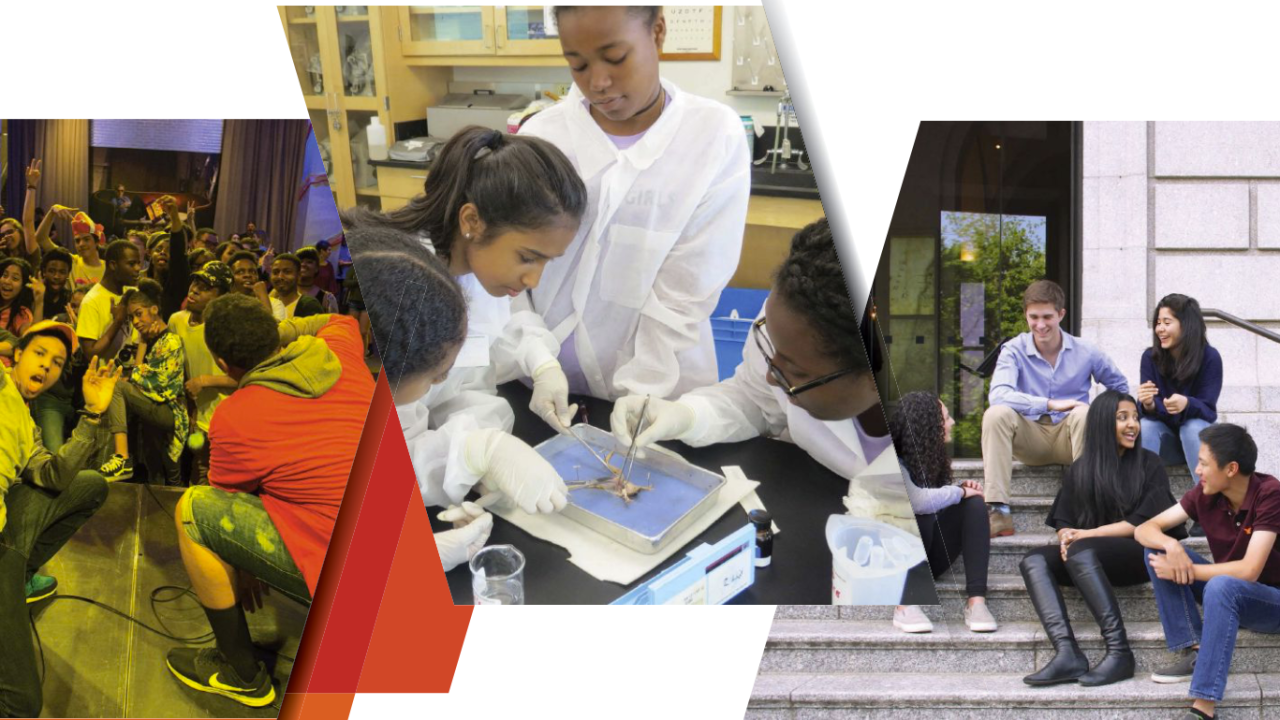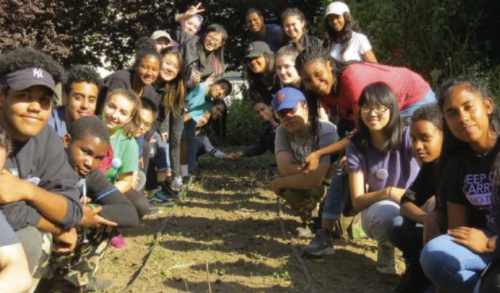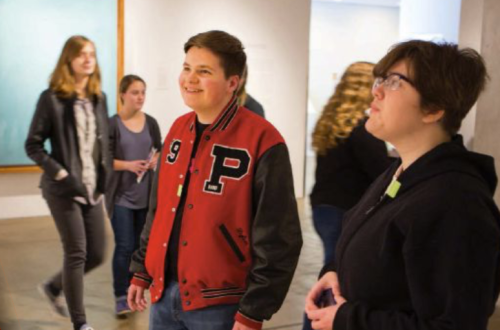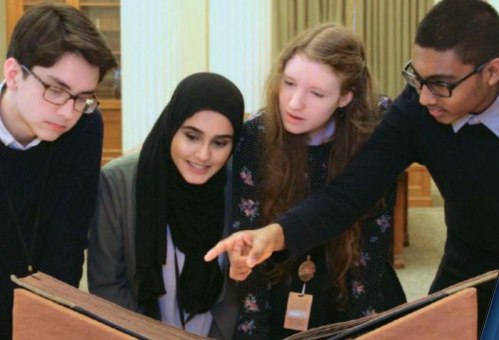
This article originally appeared in the March/April 2018 issue of Museum magazine.
A look at teen programs that are preparing the next generation of museum visitors, staff, and supporters
Here’s a sight every museum professional has witnessed: a wide-eyed elementary school child who is experiencing his or her first dinosaur skeleton, mummy, or giant sculpture. It’s a special moment. But as those children hit their teen years, getting them excited about museum visits becomes a little more difficult—like most things in the teen years.
Engaging teen audiences takes planning and investment, but it’s worth it. Proof: the 2015 Whitney Museum of American Art research study Room to Rise: The Lasting Impact of Intensive Teen Programs in Art Museums found that teen programming offers participants a lifelong engagement with arts and culture, personal and professional development, and opportunities to build leadership skills and civic engagement.

Youth Leadership Institute (YLI) visit the Youth Farm
at the School for Public Service in Brooklyn. The YLI students, who readied the farm for winter, learned about sustainable agriculture in the city and how it relates to access to quality food and health issues.
“Museums across the country are doing essential work in engaging adolescents as they move beyond simply getting teens in the front door to offer authentic, transformative experiences for an age group that seeks personal meaning, embraces risk, thrives on peer relationships, and values supportive adult mentors,” the report says.
“Treated as individuals with much to contribute, participants become involved co-creators of museum experiences rather than passive recipients of information or educational services.”
While the report focuses on art museums, various types of museums are creating teen experiences with similar goals and results. Below are snapshots of teen programs that illustrate the breadth of strategies museums are using to prepare the next generation for personal, academic, and professional success—and instill a better appreciation of what museums have to offer.
Prioritize Self-Discovery
The extensive slate of teen programming at The Andy Warhol Museum ranges from the Youth Invasion, an annual celebration in which teen artists, performers, and designers take over the museum and showcase their talent, to an LGBTQ+ prom that attracts hundreds of youth. Approximately 3,800 teens participate in all of the museum’s programs.

Teens can become paid student assistants who work in education and outreach programs like the Youth Open Studio, a free drop-in printmaking workshop at a local artist-run printmaking facility. Or they can apply for the Youth Arts Council, a yearlong leadership program in which students receive a stipend and collaborate with staff and artists, create art, plan events, or work in areas of the museum like The Factory, where visitors of all ages explore Warhol’s art-making techniques.
“Teens are not just an audience for The Warhol— they are an essential part of our staff”
“Teens are not just an audience for The Warhol— they are an essential part of our staff,” says Danielle Linzer, director of learning and public engagement. “They gain real-world skills, engage with a creative community, and learn about new artistic processes and approaches.”
Enable Scholarly Pursuits
At the New York Historical Society, the decade-old teen programming includes a weeklong Scholars Program for youth who are interested in American history and developing their research skills. During the spring sessions, 16 participants conduct research using artifacts from current exhibitions, and in the summer sessions they access the print, manuscript, and photograph collections in the institution’s Klingenstein Library and publish their research online.

“The teens have a choice in what type of history they’re researching, and they have a sense of responsibility,” says Kinneret Kohn, manager of teen programs.
“They’re contributing their research and scholarship to a larger field and influencing how others learn… Even students who go into biology or medicine or engineering have said the skill sets they learned here have helped them in their careers.”
In the society’s two-tiered internship program, sophomores, juniors, and seniors first become Student Historians, conducting research and developing tours. After completing that tier, returning students can serve as Teen Leaders, supporting family programming, researching and planning a thematic exhibition, or developing exhibit programming. For example, during December school vacation week, some Teen Leaders design an early childhood family program that is tied to an exhibition and features a storybook and a related hands-on activity.
“We recognize the value of teens having meaningful opportunities with real responsibilities and work experience,” says Kohn. “Whether they are putting on a museum-quality exhibit or leading a tour, we put a lot of responsibility into teens’ hands, and that translates into great learning for them.”
Introduce Career Options
GOALS for Girls (Greater Opportunities Advancing Leadership and Science) at the Intrepid Sea, Air & Space Museum in New York offers 50 rising 9th and 10th graders a free six-week summer intensive to learn about STEM (science, technology, engineering, and math) careers.
Students visit STEM organizations, meet with women who have STEM jobs, and visit an Ivy League institution. After the summer program, they participate in monthly follow-up forums that feature a STEM-related speaker or other presentation. About half of the girls take advantage of the opportunity to apply for one of 25 paid museum internships at the end of the program.
In addition, the Youth Leadership Institute at Intrepid is a yearlong, coed program for high school juniors that focuses on leadership, public speaking, service, and engaged citizenship. Activities include presenting information to museum visitors, visiting colleges in and around New York City, and participating in service projects like cleaning invasive species out of New York’s Van Cortlandt Park.
“Our mission promotes the appreciation of history, science, and service, and I think these programs may actually be the best example of those three things tied up together,” says Lynda Kennedy, vice president, education and evaluation. “But you have to take down all barriers. Internships have to be paid or we’ll lose the teens to typical, paid after-school jobs at McDonald’s or the Gap.”
Kennedy says the museum seeks out teens “who may not have the social capital to capture the best internships” by reaching out to schools, community centers, and other youth-serving organizations to publicize the programs and the application process.
Evolve as Necessary
The Smithsonian Latino Center’s Young Ambassadors Program fosters and supports the next generation of Latino leaders in the arts, sciences, and humanities. During the summer before beginning college, up to 24 participants from across the country attend Washington Week, an opportunity for leadership development and skill-building training, as well as visiting the Smithsonian’s Latino collections and interacting with Latino experts from different fields, such as an artist whose work hangs in the National Portrait Gallery and an astronaut who is the son of migrant workers.
“After our first Washington Week in 2006, we conducted a study and realized we needed to add an opportunity for students to implement the skills they learned during that week,” says Emily Key, education programs manager. Participants now follow Washington Week with a four-week internship at one of 17 museums across the US and Puerto Rico. “We want them to build change in their local communities,” Key says, “so they do internships in marketing, education, public programming, and community outreach where they are directly involved in community-facing activities.”
Further evaluation revealed that program alumni were interested in professional development and additional opportunities to connect with their communities. The program now offers alumni sessions on resumes, interviewing, taxes, and budgeting; an alumni blog; and community outreach events where alumni talk about college, goals, and opportunities.
Encourage Activism
Students Opposing Slavery (SOS) is a program at President Lincoln’s Cottage that grew out of a connection among four passionate high school students, Cottage staff, and individuals around the world who want to prevent human trafficking.
“The students’ goal was to use their voice to reach their peers and raise awareness about this issue, so we agreed to work with them,” says Callie Hawkins, associate director for programs at the Cottage. The programming includes an International Summit at which students gather at the Cottage to hear presentations from survivors, NGO representatives, law enforcement, relevant federal agency officials, and others.
“Everyone who works on this issue agrees that education is prevention,” Hawkins says. “The founders wanted it to be student-led and driven, so we give students the tools to start the clubs at their schools. . .and we also encourage them to do at least one project.” She is consistently impressed with these projects, which have included organizing school assemblies, film screenings, and art installations on the subject.
Keep It Fresh
The American Museum of Natural History has spent decades doing targeted programming for all ages. “For teens, it’s an identity-building moment and a time to develop a familiarity with the museum as a resource, to find out what interests them, and create a passion for science,” says Leah Golubchick, manager of middle and high school programs and institutes.
“For teens, it’s an identity-building moment and a time to develop a familiarity with the museum as a resource, to find out what interests them, and create a passion for science”
With feedback from the museum’s Youth Alumni Committees, Golubchick does a lot of programmatic experimentation. Based on the popularity of the SciCafes for an over-21 audience, she created the equally popular Teen SciCafe. This informal afternoon program consists of games, refreshments, social activities like a museum photo booth, and a scientist presentation and Q&A.
“We want [the teens] to be enthusiastic about natural science and the natural world,” says Golubchick. “When a conservation scientist recently spoke about black bear behavior and said she was a bear biologist, students said, ‘I didn’t even know that was something you could do!’ ”
A new five-month pilot program will teach 25 teens how the combination of data and technology leads to scientific discoveries. “Teens love any experience that gives them access to behind-the-scenes activities,” Golubchick says. “There is a lot of cutting-edge technology around scientific research, and [participants] will work with museum scientists and learn what is exciting about the future of this research.”
Dedicated teen programming benefits everyone involved. Teens receive valuable education, training, and guidance, while museums expand their reach to a new generation that develops a lifelong appreciation of what they offer. After all, the teenage years are a time of exploration; what better place to do that than in a museum?
Resources
Room to Rise: The Lasting Impact of Intensive Teen Programs in Art Museums
whitney.org/Education/Teens/RoomToRise
“The Mall Over the Museum,” Museum Magazine, September/October 2009







